Notice: Undefined variable: page in /home/vrxdg1855sn3/public_html/wp-content/themes/72tree/content.php on line 15
Notice: Trying to get property 'ID' of non-object in /home/vrxdg1855sn3/public_html/wp-content/themes/72tree/content.php on line 15
Metallic Wood-Boring Beetles Damaging Your Trees
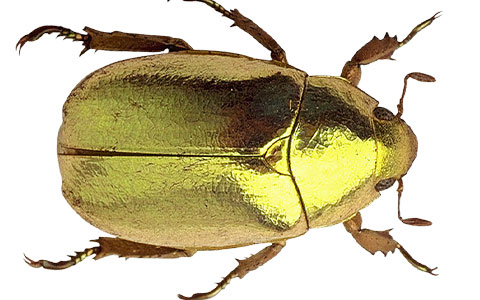
Prevent your trees from dying when metallic wood-boring beetles infest your area. By knowing how to identify these destructive beetles, you can take action to protect and treat your trees.
72tree.com assembled the following information on metallic wood-boring beetles (jewel beetles), the damage they cause to trees, how to protect your trees, and who to call when you identify their presence.
Metallic Wood-Boring Beetles (Buprestidae) – Jewel Beetles
Jewel beetles or metallic wood-boring beetles are members of the Buprestidae family of beetles, consisting of over 15,000 known species. The larvae of this immense beetle family are known as flathead borers. These beetles possess the following traits:
Appearance – Beetles have six legs and short antennae. Nearly all adult jewel beetles will have some metallic coloration on their body. In contrast, the brightest coloration typically appears under the wing covers (elytra) or on the insect’s underside.
Size – These beetles are generally cylindrical or elongated to oval, with lengths from .12 to 3.15 in; most species are under .80in.
Feeding Habits – Adult beetles of the Buprestidae family feed on their host tree’s foliage, causing little damage to the tree.
The larvae of these beetles burrow through the bark, roots, and stems of multiple species of trees and woody plants to reach the cambium (water and nutrient delivery system of the tree).
Some of the more well-known jewel beetles include:
•Emerald Ash Borer (Agrilus planipennis)
•Golden Buprestid (Buprestis aurulenta)
•Bronze Birch Borer (Agrilus anxius)
•Red-legged Buprestis (Buprestis rufipes)
•Flathead Apple Tree Borer (Chrysobothris femorata)
•Anthaxia (Anthaxia)
•Oak Splendor Beetle (Agrilus biguttatus)
•Eurythyrea austriaca (Linnaeus, 1767)
Note: Scientists at the Georgia Institute of Technology in Atlanta uncovered that jewel beetle color results from light-reflecting properties of the cells comprising their external skeletons. This research suggests that a jewel beetle’s color results from its physical structure (cell alignment) rather than pigment’s light-absorbing properties.
For important information about the emerald ash borer, read 72tree.com/emerald-ash-borer-tree-damage/
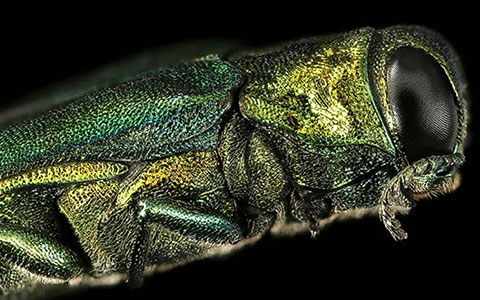
Metallic Wood-boring Beetle Life Cycle
As with most beetle species, their life cycle can be separated into 3 distinct phases, including:
Adult – In spring and summer, adult beetles emerge from their host and feed on its foliage while searching for a mate. Adult jewel beetles are typically short-lived, living only for a few weeks.
Egg – Females lay eggs in crevices in the bark of the same or a nearby tree.
Larva – After hatching, larvae bore into the host until reaching the nutrient-rich cambium of the host tree, where it feeds, grows, and pupates.
Most species have one generation per year or take multiple years to develop. However, some species may produce multiple generations per year.
Metallic Wood-Boring Beetle Infestation Identification
While visual confirmation of adult beetles is best, the following symptoms indicate that a metallic wood-boring beetle infestation is occurring:
•Partially consumed foliage (Leaf notches)
•Chlorosis of foliage in sections of the crown
•Dieback of foliage and stems
•Frass (sawdust) found on the bark from burrowing activities
•D-shaped exit holes in tree bark
•Bulging or vertical splits in the bark (over larval galleries)
•Suckers and water sprouts growing in the crown, on the trunk, and/or from the roots
•Woodpecker damage (woodpeckers hunt beetle larvae)
•Squirrel activity (some squirrel species feed on beetle larvae)
•Adults found in traps
Combined, the beetle’s different stages’ feeding habits will leave a tree with damaged, wilting foliage, and in rapid decline.
As larvae continue to feed, they channel through their host’s cambium layer in a zigzag or ribbon pattern. This feeding ultimately leads to a partial or total girdling of the host, resulting in hydraulic failure and death.
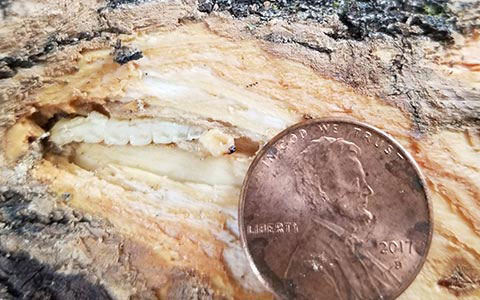
Affected Tree Species – Some tree species especially susceptible to wood-boring beetles in the Buprestidae family include:
•Pine (Pinus)
•Spruce (Picea)
•Fir (Abies)
•Hemlock (Tsuga canadensis)
•Ash (Fraxinus)
•Beech (Fagus)
•Hazelnut (Corylus)
•Apple (Malus domestica)
Generally, Buprestidae prefer attacking trees and woody plants in decline or dying. However, a number of the species will attack “green,” flourishing specimens. An example of this is the emerald ash borer (EAB), which has decimated the ash tree population in many parts of the US and continues on the move.
Note: Many wood-boring beetle species seek, attack, and infest specific tree families like the emerald ash borer that attacks those species within the ash family.
Metallic Wood-Boring Beetle (Buprestidae) Control and Prevention
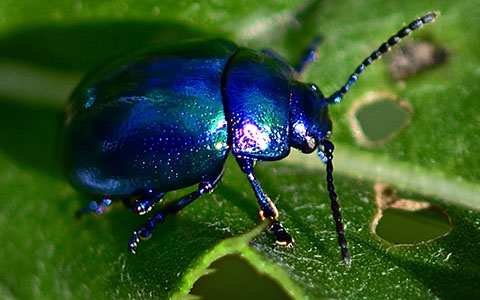
Due to their larvae’s hidden feeding activities, preventing a metallic wood-boring beetle infestation is not always possible. However, the following practices will help reduce the risk of an infestation:
•Select well-adapted species of trees not commonly attacked by wood borers in your area.
•Choose and prepare a suitable planting site to avoid tree stress, freeze damage, sunscald, windburn, and other stressors.
•Use proper watering and fertilization methods.
•Use proper seasonal pruning practices (winter/dormant season).
•Avoid mechanical injury to tree trunks from lawnmowers construction.
Your trees’ care includes the safe removal and destruction of infested, diseased, and dying trees from your property and surrounding areas.
Most of the time, wood-boring insects are secondary invaders (successfully attacking a tree already in decline). For a tree, the first line of defense against any infestation is to keep them healthy. Proper care of trees and woody plants discourages many borer pests. Good sap flow from healthy, vigorous trees, for example, defends the plant from damage by many borer pests.
If you have confirmed a boring insect infestation on or near your property, immediately contact an ISA certified arborist to evaluate your property’s risk and recommend a course of action.
Note: If you are inclined to use chemical treatments on your trees or as a ground soak, allow a professional to apply it. To chemically stop or prevent a boring insect infestation, such products must be applied correctly and at the right time.
Jewel Beetles (Buprestidae)
In this article, you discovered essential information about metallic wood-boring beetles, their appearance and life cycle, how to identify an infestation, and how to prevent or control these deadly beetles.
By taking swift action to prevent or control a jewel beetle infestation, you are helping all of the trees on and around your property.
When you allow a wood-boring beetle infestation to go unchecked, you can be responsible for devastating infestations spreading far beyond your property.
Sources:
texasinsects.tamu.edu/woodborer-metallic-woodboring-beetle/
extension2.missouri.edu/g7422
fs.usda.gov/Internet/FSE_DOCUMENTS/stelprdb5320268.pdf
nsf.gov/news/news_summ.jsp?cntn_id=115304
Notice: Undefined variable: page in /home/vrxdg1855sn3/public_html/wp-content/themes/72tree/content.php on line 15
Notice: Trying to get property 'ID' of non-object in /home/vrxdg1855sn3/public_html/wp-content/themes/72tree/content.php on line 15
How To Remove a Tree Stump Without a Grinder
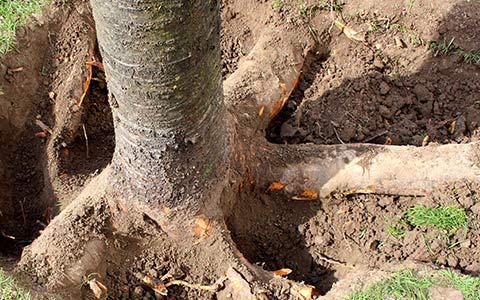
Avoid spending hundreds of dollars hiring a firm or renting a grinder to remove your tree stump. By knowing how to safely remove a tree stump, you can regain your landscape and save money.
72tree.com assembled the following information on methods for removing a tree stump without a grinder and crucial safety measures to observe.
Manual Tree Stump Removal
You can remove small and medium-sized stumps yourself with a few tools, some ingenuity, and muscle. When it comes to more massive stumps, you may want to get the help of a friend or relative to speed up the job and help with the heavy lifting.
Project Time: Manually removing your stump could take as little as 4 hours or up to 12, hours depending on the root ball’s number of roots and depth.
Removal Time: 4 to 12 hours
Tools, Protective Gear, and Costs:
•A sturdy and sharp shovel $15 to $35
•A mattock (similar to a pick-ax) $20 to $30
•An ax $25 to $45
•A steel 17Lb+ digging bar $30 to $40
•A bow saw $12 to $50
•Sturdy steel-toed boots $50 to $100
•Well-fitting work gloves $5 to $25
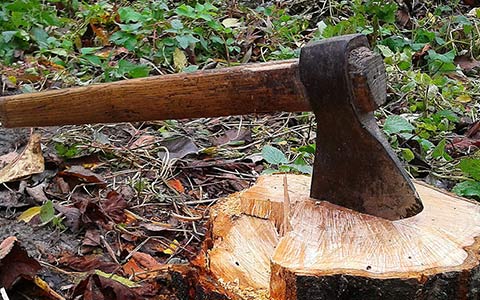
Your work gloves should snugly fit your hands. Loose gloves will move around, rub the skin, and cause blisters (defeating the purpose of wearing them).
Removing The Stump
1. Use the mattock, digging bar, and shovel to clear as much of the soil from around the stump and roots. Dig deep and wide to gain access to as many of the roots as possible. The larger the stump, the more soil you will need to remove.
2. Use the bow saw, mattock, and an ax to chop your way through the roots. When wielding an ax, take care to avoid over-chopping into the soil; this will quickly dull the blade.
3. As you cut roots away from the stump, cut them a second time to remove them from your work area.
4. Work your way around and under the root ball. Some species will grow a taproot, and this root will require some effort to sever. The more mature the tree, the more substantial the taproot will be. Dig deep and wide to gain as much access to this root as possible.
5. Once the stump is free, drag it out of the hole and fill in the void. (it will take more soil to fill in the hole than you removed from it).
Note: If you are not comfortable or knowledgeable using an ax, DO NOT use one. This tool can inflict severe harm if misused, use your mattock and/or bow saw in its place.
Tip: You can save a lot of time using a pressure washer to clear soil away from roots. Do this in sections and let the excess water soak into the ground. You can also dig a trench to guide water and soil away from your work area as you blast through the soil.
Chemical Tree Stump Removal
Just because there is no trunk or canopy, your stump may still be alive. Other trees in close proximity may be sharing water and sugars through their root systems, or your stump’s roots may have enough stored water and nutrients to attempt a comeback.
If multiple trees are connected by roots, the use of harsh chemicals on your stump may have adverse effects on the trees helping it to stay alive. Read more about killing tree stumps at 72tree.com/how-to-kill-stop-tree-stumps-growing-back/
You can remove medium and large-sized stumps chemically. While this process is much slower than manually removing the stump, it will save you from digging up your yard.
Project Time: Your stump’s height and diameter are determining factors for this project. It can be done in 1 hour and last as much as 4 hours.
Removal Time: 6 months to 1 year
Tools, Protective Gear, and Costs:
•A chainsaw (if you need to lower the height of the stump) $60 to $250
•A bow saw $12 to $50
•A drill and large boring bit (use the largest bit you can find) $70 to $200
•Plastic tarp $4 to $18
•Potassium-nitrate stump remover granules or high-nitrogen fertilizer $15 to $25
•Organic mulch $15 to $25 (free if you compost)
•Sturdy steel-toed boots (if using a chainsaw) $50 to $100
•Well-fitting work gloves $5 to $25
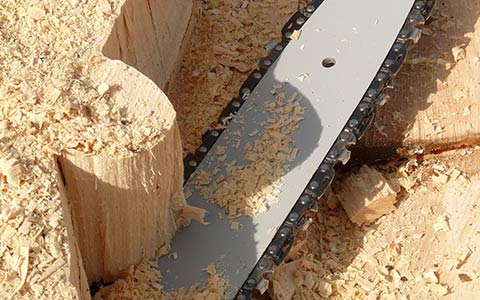
A note about the removal time: This process relies on the breaking down of organic matter and relies on warmth and moisture. In cooler climates, removal time may exceed 1 year while in warmer climates, this time may be less than 6 months.
Removing The Stump
1. Use your chainsaw or bow saw to lower the height of the stump. The lower to the ground, the more efficient this process will be.
2. Dill several deep holes in the stump. Use the widest bit available to you and drill the holes close together.
3. Fill each hole with water and your remover granules or fertilizer (don’t be shy, pour it in).
4. Use a soaker hose to saturate the soil surrounding the stump and apply a 3 to 6-inch layer of organic mulch over and around the stump.
5. Cover the stump and mulched area with a tarp to further retain the moisture.
6. Secure the tarp by staking it, covering it with a thick layer of organic mulch, and placing heavy objects (rocks and/or potted plants) on it.
7. Every 2 to 3 weeks, remove the tarp, repeat steps 3 and 4, and replace the tarp.
Under optimal conditions, the stump may soften within 3 to 4 months. It can then be broken up with an ax, retreated, and completely buried to further decay underground.
Note: Protect yourself with gloves, protective glasses, and clothing when using or dispersing chemicals. Wash your hands and any exposed body parts thoroughly after completing this job.
Tip: When having a tree removed, request that the tree be cut as close to the ground as possible. By doing this, you will save a lot of time when chemically removing your stump.
Caution: While other, more caustic agents like muriatic acid can be used to chemically remove a stump, they bring severe health hazards with them. Many acids do not require physical contact to cause harm, inhaling their vapors can cause significant respiratory damage. Avoid using such chemicals to preserve the health of your loved ones and surrounding wildlife.
Tree Stump Removal by Fire
You can remove medium and large-sized stumps by burning them. Before embarking on this method, verify that there are no municipal restrictions or forbiddance by HOA rules on burning out tree stumps.
Project Time: Depending on the freshness of your stump, this project can be done in 1 hour and last as much as 2 hours.
Removal Time: 1 day
Tools, Protective Gear, and Costs:
•A drill and large boring bit (use the largest bit you can find) $70 to $200
•A sturdy and sharp shovel $15 to $35
•Kerosine $2.70 to $3.30 per gallon (pricing varies with fuel market values)
The more time your tree stump has had to dry out, the more effective this method will be. However, stump removal by fire can be used at any time.
1. Start by digging a trench around your stump 4 to 6-inches deep and 10 to 12-inches wide. This will remove grass and debris that might ignite.
2. Drill several holes as wide and as deep as you can into the stump, the more, the better. Using a hammer and chisel, bore out a deep hole 3 to 4-inches wide in the center of the stump.
3. Pour kerosine into all of the holes and let the stump soak it up. Repeat this step several (3 to 4) times before lighting the stump on fire.
4. When you are ready to light the stump, apply kerosine once more. The larger, center hole should be wet with kerosene and filled with charcoal to intensify the heat. Ignite the stump from a safe distance.
5. Let the stump burn completely before disturbing it.
6. Anything left after this method should be easily broken apart and buried where the stump once was.
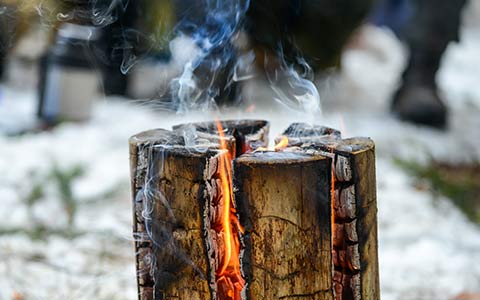
Tip: Keep a fire extinguisher and water hose close by when burning a stump. If winds pick up, embers may be blown to surrounding structures, use the hose to extinguish the embers.
Caution: Kerosine floats on water. If you must extinguish the fire, use a fire extinguisher on the stump. The use of water may carry lit kerosine spraying in all directions.
Tree Stump Removal
Along with the options presented in this article, come specific hazards that should be addressed when attempting to remove a tree stump. If, at any juncture, you feel that you cannot safely remove your tree stump, stop what you are doing, and call a professional tree service to remove the stump for you.
How To Remove a Tree Stump
In this article, you discovered multiple methods for removing a tree stump without using a stump grinder and crucial tips to speed up the job and keep you safe.
By following some simple instructions and properly using your tools, you can remove your tree stump without the cost or mess of using a stump grinder.
Improperly trying to remove a tree stump may result in catastrophic physical injuries leading to costly medical bills and health consequences.
Sources:
extension.sdstate.edu/how-remove-stump
extension.illinois.edu/blogs/rhonda-ferrees-ilriverhort/2014-06-20-removing-tree-stumps
warnell.uga.edu/sites/default/files/publications/Stump%20Removal%20pub_14-8.pdf
Notice: Undefined variable: page in /home/vrxdg1855sn3/public_html/wp-content/themes/72tree/content.php on line 15
Notice: Trying to get property 'ID' of non-object in /home/vrxdg1855sn3/public_html/wp-content/themes/72tree/content.php on line 15
Symptoms of Anthracnose
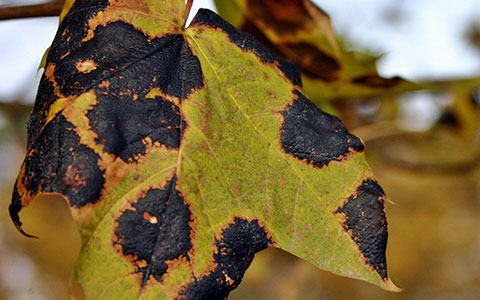
Prevent anthracnose from harming your trees, shrubs, and turf, causing their decline and eventual death. By knowing how to identify this pesky fungal disease, you can take steps to control and prevent it.
72tree.com gathered information to help you identify the symptoms of anthracnose, what it infects, how to treat it, and how to prevent the disease.
What Is Anthracnose
Anthracnose is the name given to a group of fungal pathogens that attack a wide variety of herbaceous and woody plants in spring with cool and wet weather. Fungi overwinter (lie dormant) in dead twigs and fallen leaves. Cool, rainy weather provides perfect conditions for emerging spores to spread.
Anthracnose Symptoms
Anthracnose symptoms can appear differently depending on what part of a plant or tree it has infected. The following will help you positively identify an anthracnose infection:
Twig, Branch, and Stem/Trunk Symptoms – Anthracnose infections on twigs most commonly appear as small orange-brown blisters or as a brown band encircling and girdling the young twig resulting in shoot death.
In more advanced cases, anthracnose can cause open wounds on branches, stems, and trunks. These open wounds typically appear sunken, dark, and wet.
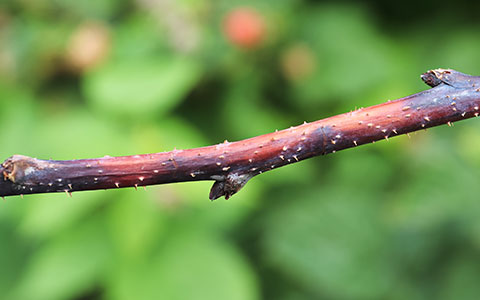
Leaf Symptoms – Tan to dark brown irregular shaped blotches develop on young leaves, and they are typically distorted, cupped, or curled. When there is a severe anthracnose infection, premature leaf drop can occur in spring. When this happens, trees will usually produce a second growth of foliage by midsummer.
An anthracnose infection may cause identical spots on mature leaves. Still, these leaves generally do not portray the cupped or distorted appearance. These spots on mature leaves are frequently accompanied by minor wounds from insect feeding.
For trees, these symptoms are typically most severe on lower and inner branches but can travel up through the entire canopy.
Fruit Symptoms – Anthracnose fruit rot is identified as brown to black, water-soaked, sunken spots on green and ripe fruit. These lesions can develop over time, depending on weather conditions during disease development.
Grass/Turf Symptoms – Anthracnose diseases are common and destructive problems in landscapes and golf course greens with creeping bentgrass or annual bluegrass.
Anthracnose may develop in grasses as a foliar blight, in which grass leaves are infected, or a basal rot, attacking leaf sheaths, crowns, and stolons.
Anthracnose symptoms in grass and turf can be highly variable. Consider the following:
•Yellow to orange spots in irregular patterns
•Small freckle-like spots
•Circular patches reaching a foot in diameter
Symptoms are typically most severe in areas that are stressed from low mowing, excessive traffic, or inadequate irrigation or fertilization.
These symptoms first appear on the oldest growth, which dies back from the tip. The disease then gradually progresses to the younger leaves.
As the disease progresses from the foliage to basal rot, the leaf sheaths, crowns, and stolons will be darkened and rotten.
Tip: Use a magnifying glass to identify acervuli. These black, saucer-shaped pads with protruding black spines (setae) are the disease’s reproductive structures filled with spores.
Anthracnose Disease Cycle
An anthracnose disease cycle starts when a host is infected in spring or early summer from spores in fallen leaves, infected twigs/limbs, and lesions called cankers. Leaf infections commonly progress to stem and bud infections where the pathogen continues to grow and cause dieback.
Dieback is frequently the result of cankers growing over multiple years and, unless treated, will result in hydraulic failure to foliage, the decline in health, and vulnerability to deadly pathogens and/or infestations.
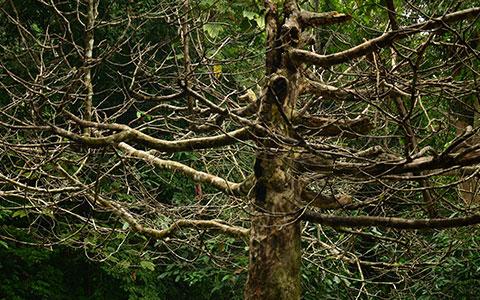
Generally, anthracnose infections are not lethal to plants and trees. But, if the pathogen is left to flourish for multiple growing seasons, it will weaken its host, allowing other diseases or insects to successfully attack and kill it.
Anthracnose Treatment
Due to the ease in which anthracnose spreads and infects plant life, once identified, fast action is required to prevent a wide-spread, severe outbreak. The following will help you reduce transmission of the pathogen:
•Apply a broad-spectrum, non-toxic bio-fungicide safe for organic use directly on and around infected areas
•Halt all overhead watering practices and install drip lines where possible
•Carefully prune and destroy all infected foliage, stems, and branches
•Collect and destroy fallen leaves, twigs, and debris from beneath infected trees, shrubs, and plants throughout the growing season and summer months
•Sanitize all pruning and gardening equipment after each use with a one part bleach to 4 parts water solution
•Call a professional tree service to treat cankers on tree trunks (tree removal may be required in more severe stages of infection)
•Do not walk through or work on your garden, lawn, or shrubs when they are wet
•Avoid composting infected foliage, fruit, cuttings, or stems
•Thoroughly clear debris from gardens and from under shrubs and trees in the fall to reduce overwintering opportunities for fungal spores
Read more about treating and eliminating fungi at 72tree.com/how-to-get-rid-of-tree-fungi/
Anthracnose Prevention
While it can be challenging to prevent, the following measures will help you protect your garden, bushes, and trees from anthracnose:
•Use western grown seeds which have not been exposed to anthracnose
•Plant disease-resistant species when possible
•Water, fertilize, prune, and mulch your plants and trees to promote their health
•Apply liquid copper sprays weekly throughout the growing season
•Apply sulfur powders weekly throughout the growing season
•Apply neem oil at the first sign of budding, then weekly throughout the growing season
Note: Neem oil is an organic, multi-purpose fungicide, insecticide, and miticide eliminating all stages of insects while preventing fungal attacks.
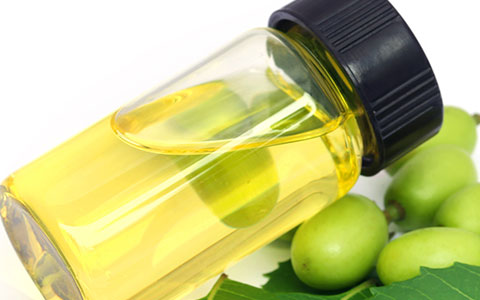
Anthracnose Symptoms, Treatment, and Prevention
In this article, you discovered what anthracnose is, how to identify it, and measures to treat and prevent it from harming your landscape.
By taking swift action to halt the progression and prevent anthracnose infections, you are preserving the health of your grass, plants, shrubs, and trees.
Allowing anthracnose to spread without treatment will leave the plant life on your landscape in poor health and susceptible to more deadly pathogens and infestations.
Sources:
extension.umn.edu/plant-diseases/anthracnose-trees-and-shrubs
content.ces.ncsu.edu/anthracnose-in-turf
ipm.illinois.edu/diseases/series600/rpd621/index.html
missouribotanicalgarden.org/gardens-gardening/your-garden/help-for-the-home-gardener/advice-tips-resources/pests-and-problems/diseases/anthracnose.aspx
Notice: Undefined variable: page in /home/vrxdg1855sn3/public_html/wp-content/themes/72tree/content.php on line 15
Notice: Trying to get property 'ID' of non-object in /home/vrxdg1855sn3/public_html/wp-content/themes/72tree/content.php on line 15
Tree Blowndown Windthrow and Windsnap
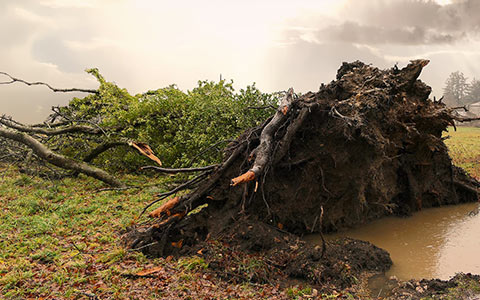
Don’t let your tree die from being toppled in a storm. Knowing how windthrow and windsnap can topple trees will help you increase their natural defenses against it.
72tree.com gathered information on what windthrow and windsnap are, what causes them, and how they can be prevented.
What is Windthrow?
Windthrow occurs when trees are toppled by wind. When windthrow occurs, trees are uprooted as they are blown over.
What is Windsnap?
Windsnap also occurs when trees are toppled by wind. When windsnap occurs, trees are broken off at the trunk as they are blown down.
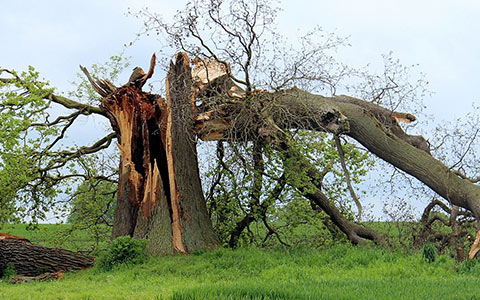
Windthrow and Windsnap Causes
While wind is a contributing factor to windthrow and windsnap, it is not the primary cause (under normal circumstances). Consider the following:
What Causes Windthrow – Windthrow can topple the seemingly sturdiest of trees in the lightest of breezes or most furious of winds. Consider the following conditions that can lead to windthrow:
•Earthquakes can loosen tree roots from their soil, leaving the tree destabilized
• Floods can over-saturate the soil surrounding a tree, leaving roots with nothing to grip
• Excessive rains can also over-saturate the soil around a tree
• Snow accumulation can add enough weight to the tree to overpower its roots
• Construction activities can cause soil compaction, leading to root death
• Deep trenching too close to a tree can sever its roots
• Erosion can strip soil and sediments away from the root plate, leaving roots exposed
• Root rot caused by disease, leaving roots soft and without anchoring power
• Improper watering can cause roots to grow too close to the surface, offering little to no support
Either by nature or neglect, when roots are destabilized, any amount of wind can catch the tree’s canopy, disrupt its balance, and topple it without notice.
Note: A tree’s root plate expands outward from the trunk and continues to its dripline. While roots can grow beyond the dripline, those within it should be nurtured and protected throughout the tree’s life.
What Causes Windsnap – Windsnap brings down trees when the trunk/stem snaps, completely separating the crown and a portion of the trunk from the root system left in the ground. The following conditions can lead to windsnap:
• Sudden severe wind “microbursts”
• Poor trunk and limb development from bad pruning practices
• Diseases that cause hydraulic failure like blight
• Heart rot caused by fungi that feed on the inner wood of the trunk
Another term used to represent both windthrow and windsnap is “blowdown.” This term is usually applied when both windthrow and windsnap occur in the same place. Events that can lead to blowdown include:
•Hurricanes
• Tornadoes
• Typhoons
• Tropical storms
• Hail storms
• Bomb detonations
• Factory explosions
• Volcanic eruptions (pyroclastic flows)
• Meteor impacts or atmospheric explosions
For trees that somehow manage to remain standing after such events, they will likely have been stripped of their leaves and bark, sentencing them to certain death.
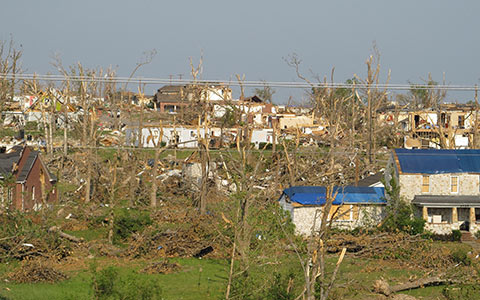
Note: In 1980, the eruption of Mt. St. Helens destroyed more than 4 billion board feet of timber by windthrow and windsnap.
In 1945, an atomic bomb was detonated 2,000 feet over the city of Hiroshima, destroying five square miles of the city and flattening nearly all vegetation. Incredibly, 170 trees survived the explosion within one and a quarter-mile of ground zero, and are alive today.
And in 1908, the Tunguska explosion (believed to have been a meteorite) caused a blowdown of trees within 2,000 square kilometers of forest.
Windthrow and Windsnap Prevention
We can’t stop the weather. Even with all of the technology and advanced warning systems available, we still cannot reasonably predict how severe weather events will affect our trees. The following will help you fortify your trees to keep them from suffering windthrow and windsnap:
Planting – You can best protect your tree by planting it in a location observing the following:
• Plant your tree in a location protected from prevailing winds or known storm paths
• The location should be well-drained and not prone to flooding
• The sun/shade ratio should accommodate the tree species
Be mindful of the structures (fences, sheds, buildings, hills, etc.) and vegetation that surround the tree and can serve as a windbreak.
Read 72tree.com/beginners-guide-tree-planting/ for more tree planting tips.
Watering – Watering your tree is fundamental in encouraging roots to grow deep, offering improved stability and resistance to windthrow:
•Water newly planted trees three to four times per week
• During periods of drought, increase the frequency and duration of waterings
• Do not use overhead watering, it spreads disease, instead, use a drip or soak method
Water benefits every aspect of your tree’s health and long life. Without it, hydraulic failure can cause its fast and untimely death.
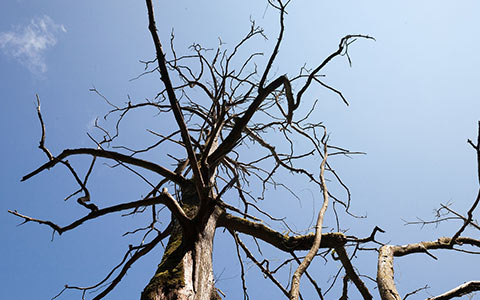
Fertilizing – When planting and each year after that, the soil (principally within the dripline) should be tested to gauge the amount of nutrients and pH level. Liquid, granular, and organic fertilizers can be used to adjust your soil as needed.
Mulching – Mulching the root plate will help the soil retain moisture and regulate soil temperature throughout the year.
Pruning – Proper seasonal pruning will encourage healthy growth and strength of your tree’s structure. Crown thinning will also help prevent blowdown by offering less resistance to wind.
Windthrow and windsnap prevention also depends on keeping your trees disease and pest free. By encouraging their growth and providing responsible seasonal care, trees are capable of fending off most threats. However, when there is a disease or pest outbreak in your region, call an ISA certified arborist to evaluate your tree and recommend preventative measures.
Read more about tree pests and diseases at 72tree.com/5-tree-pests-diseases-avoid-spring/
Windthrow, Windsnap, and Blowdown
In this article, you discovered the difference between windthrow and windsnap, what events can cause them, and steps you can take to prevent them.
By encouraging your trees to grow healthy and well-rooted, you can give them a better chance of surviving severe weather events.
Allowing your trees to grow without proper care and attention can create an opportunity for it to be blown over or snapped, causing catastrophic damages and financial loss when landing on your home or car.
Sources:
canr.msu.edu/news/why_trees_fail
fs.fed.us/r3/resources/health/field-guide/nid/windthrow.shtml
extension.purdue.edu/extmedia/fnr/fnr-faq-12-w.pdf
extension.msstate.edu/sites/default/files/publications/publications/p2683.pdf
space.com/5573-huge-tunguska-explosion-remains-mysterious-100-years.html
pubs.usgs.gov/gip/msh/impact.html
Notice: Undefined variable: page in /home/vrxdg1855sn3/public_html/wp-content/themes/72tree/content.php on line 15
Notice: Trying to get property 'ID' of non-object in /home/vrxdg1855sn3/public_html/wp-content/themes/72tree/content.php on line 15
Emerald Ash Borer Tree Damage
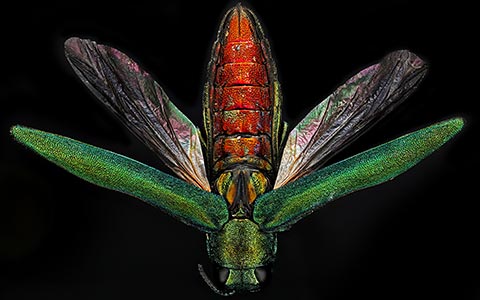
Prevent your ash tree from becoming an ecological hazard and infested by the emerald ash borer. By knowing how to confirm an infestation and who to call, you can protect surrounding trees and help in the effort to contain this tree-killing insect.
72tree.com gathered information on and how to identify an emerald ash borer infestation, how to protect surrounding trees, and when to remove your ash tree.
Emerald Ash Borer Information
The Emerald Ash borer (Agrilus planipennis) is native to eastern Asia. It is a species of beetle that completes its life cycle by going through four distinct stages:
Eggs – This borer’s eggs are laid in clusters on ash tree bark and are very small at 1/25 of an inch, and reddish-brown.
Larvae – Growing to about an inch long, larvae are white, flat, and have a segmented body. This borer’s larvae feed on the cambium and phloem of its host under the bark, leaving S-shaped tunnels or galleries as they feed. Emerald ash borers in the larval stage are responsible for the damage that leads to the eventual hydraulic failure and death of the host tree.
Pupae – In this form, the beetle is transitioning to adulthood and does not feed.
Adult – Adults are about 3/8 to 5/8 of an inch long with metallic, bright green outer wing coverings. The adult emerald ash borer has a coppery red or purplish colored abdomen that is exposed when its wing coverings are lifted. Adults will fly up to a half-mile or more to find new ash trees to nest in. Adult emerald ash borers feed on the tree’s foliage causing little or no damage to the tree.
The emerald ash borer was first discovered in the U.S., infesting dead ash trees in Detroit, Michigan, and Windsor, Ontario in 2002. This beetle is responsible for killing millions of ash trees throughout the areas where it is found.
Unlike native beetles that kill stressed or weakened trees as part of the natural nutrient recycling process, the emerald ash borer kills perfectly healthy trees.
Emerald Ash Borer Infestation Damage
New emerald ash borer infestations can be challenging to detect (they usually begin high up in the crown of the tree). By the time you detect signs and symptoms, the tree is already heavily infested, declining in health, and dying. However, if you can identify heavily infested trees, there may be enough time to protect and save lightly infested trees in the area or at least contain the spread. Consider the following signs of the beetle and symptoms of an infestation:
Signs of an emerald ash borer infestation:
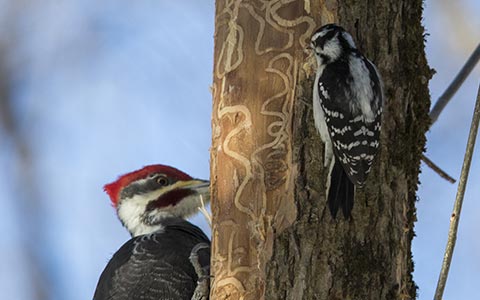
Larval Galleries – S-shaped galleries under the bark.
Exit Holes – D-shaped exit holes up to 1/8 inch wide. The size and shape of the exit holes are significant. Exit holes wider than 1/8 inch, or round holes rather than flattened on one side (D-shaped), are not emerald ash borer.
Leaf Notches – Adults will feed on ash leaves from the outer edge in, leaving notches in the leaves.
Woodpecker Activity – Woodpeckers will leave holes in the bark, surrounded by light-colored patches, as they probe beneath the bark to feed on the larvae.
Squirrel Activity – Some squirrel species will dig into the bark as they try to feed on the larvae. They leave ragged strips of bark on the trunk or stems, exposing the S-shaped galleries formed by the larvae.
Ash tree symptoms of an emerald ash borer infestation:
Epicormic Shoots (suckers or water sprouts) – When an ash tree has been successfully attacked and is under stress, it can produce epicormic shoots on the trunk, roots, and sometimes in the crown on stems and larger branches.
Bark Splits and Deformities – Infested mature trees will commonly present vertical bark splits over the location of larval galleries. On young trees with thin bark, the area over larval galleries will often dry out and turn pinkish brown while presenting vertical bark splits.
Stress Crops – Trees under severe stress can produce massive seed crops. Unfortunately, under these circumstances, few of the seeds will be viable.
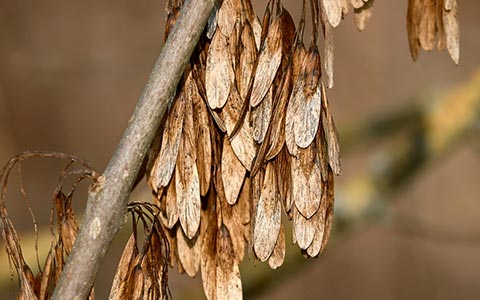
Chlorosis – As the infestation progresses, the foliage will turn yellow, wilt, and fall off the tree.
Branch Death – As the tree begins to suffer hydraulic failure, branches will die, lose their leaves, and become brittle.
Crown Thinning – Perhaps the most telling of the symptoms is the way the crown thins from the top down, leaving dead and bare branches exposed as the condition descends the tree.
You can also determine if you may be at high risk of infestation by visiting emeraldashborer.info/documents/MultiState_EABpos.pdf to see if your region or state is under Federal quarantine for the movement of emerald ash borer regulated articles.
If you detect any or a combination of the above signs and symptoms, contact a certified arborist in your area to inspect and confirm your findings. The following link explains ISA certified arborists and how to locate one in your area – 72tree.com/what-is-an-isa-certified-arborist/
Confirmed Emerald Ash Borer Infestation
Native North American ash trees possess almost no natural resistance to the emerald ash borer. Death of infested trees is at or near 100% unless managed very early on for emerald ash borer control. Once you have confirmed an infestation, immediate action should be taken to protect trees in surrounding areas.
• Call the USDA Emerald Ash Borer Hotline at (866) 322-4512 for specialized instruction and guidance (specific to your location)
• Hire an arborist to inspect and treat neighboring trees
• If your tree is beyond saving, remove it immediately
• Prevent spreading an emerald ash borer infestation by having your felled tree chipped (this process is highly effective in eliminating the borer)
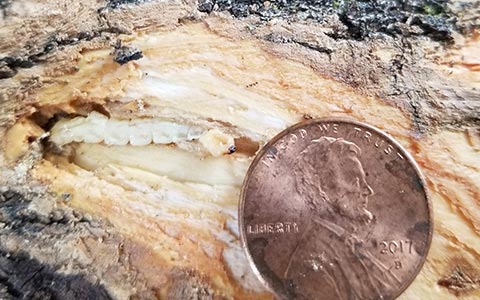
Because this killer beetle does not discriminate between sick or healthy ash trees, there is little you can do besides chemical deterrence to prevent an infestation. Preventative measures for this pest should be applied by an ISA certified arborist.
Emerald Ash Borer (Agrilus planipennis)
In this article, you discovered information about the emerald ash borer, signs and symptoms that identify it, and what to do if you confirm an infestation in your ash tree.
By taking immediate action to deal with a potential or confirmed emerald ash borer infestation, you are protecting the ash tree population in your area. Besides saving yourself from likely financial losses when you are forced to take action.
Ignoring the dangers of an emerald ash borer infestation can lead to the destruction of an entire region’s ash tree population, ecosystem, and cause catastrophic damages as dead trees begin to fall.
Sources:
ctpa.org/the-life-stages-of-eab/
ajc.com/lifestyles/environment/invasive-beetle-threatens-georgia-ash-trees-with-devastation/kTjy7UC4LocGRhSkHP7REK/
citybugs.tamu.edu/2015/10/23/recognizing-emerald-ash-borer-damage/
invasive.org/gist/moredocs/agrpla02.pdf
fs.fed.us/aboutus/budget/requests/DDBR428_Emerald_Ash_Borer_report_to_Congress.pdf
cfs.nrcan.gc.ca/pubwarehouse/pdfs/26856.pdf
orkin.com/other/beetles/emerald-ash-borer
Notice: Undefined variable: page in /home/vrxdg1855sn3/public_html/wp-content/themes/72tree/content.php on line 15
Notice: Trying to get property 'ID' of non-object in /home/vrxdg1855sn3/public_html/wp-content/themes/72tree/content.php on line 15
How To Avoid Invasive Tree Roots Destroying Your Landscape
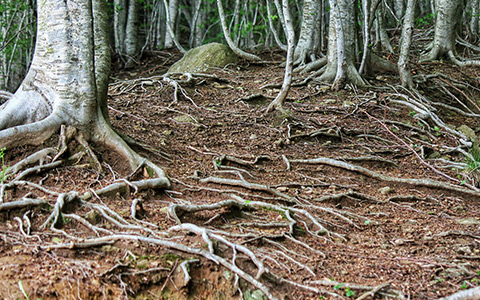
Invasive tree roots can destroy your turf, buckle concrete, and quickly become a very costly nuisance. Knowing which tree species to avoid planting and how to deal with aggressive trees already on your property will save you time, money, and stress.
72tree.com gathered information on invasive tree roots, the damages they cause, how to stop them, and which species you should not plant.
What Are Invasive Tree Roots
Invasive tree roots quickly grow in search of water and nutrients, finding their way under walkways, driveways, building foundations, sidewalks, water lines, sewer pipes, etc. As these roots thicken, they can cause these structures to fracture and buckle.
A common trait of invasive plants and tree roots is that they are fast-growing. Once these roots find a water source, they take hold and continue spreading to find more water sources.
Invasive Tree Root Damage
Once invasive tree roots spread across your yard or landscape, all they need is a water source. When that water source is tapped into, the roots thicken and tear up your turf, while breaking through nearly everything they have grown beneath.
Among the most expensive damages, invasive tree roots can cause: when they grow under the foundation of your home.
Note: These roots don’t just break through concrete or asphalt, they can cause the earth surrounding them to heave upward.
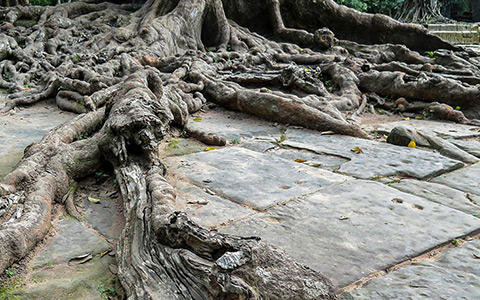
Read 72tree.com/tree-roots-buckling-concrete-driveway/ to uncover the devastation these roots can cause and ways to repair the damage they cause.
How To Stop Invasive Tree Roots
Don’t plant tree species with invasive roots. If you inherited these trees with your property or were ill-advised when you purchased and planted a tree, here are some of the measures you can take to slow these roots down:
1. Install root barriers to a depth of 18 to 24 inches (the majority of tree roots are found within the top 18 inches of soil). You can install these barriers around young trees or around structures to stop or divert the direction of the roots. When installing barriers, allow enough space for tree roots to form a stable root plate. The root plate generally surrounds the trunk and extends to the tree’s drip line.
2. Root pruning is an option that should be done by an arborist. Pruning tree roots can leave the tree vulnerable to disease and infestation.
3. After planting a tree, provide it with frequent deep waterings to encourage its roots to grow deeper.
4. Plant trees in locations where they can achieve their full growth potential without interfering with structures and landscape features.
5. Make sure the tree you are planting is appropriate for your hardiness zone. Planting outside the tree’s zone may trigger its roots to become aggressive to supply it with enough moisture.
6. Often times, the only solution for invasive root problems is to have the tree removed and the stump ground.
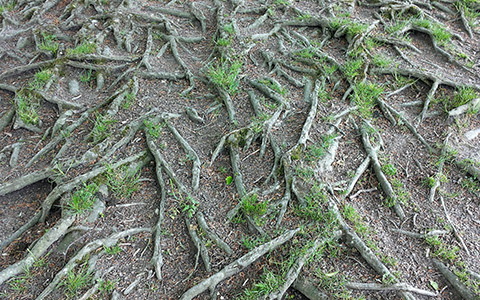
Invasive Tree Root Species
The following is a brief list of tree species that have displayed invasive root tendencies, are high-maintenance, and short-lived (when compared to similar non-invasive species):
• Aspen (Populus)
• Eastern Cottonwood (Populus deltoides)
• Empress or Princess Tree (Paulownia tomentosa)
• English Hawthorn (Crataegus monogyna)
• English Holly (Ilex aquifolium)
• English Laurel (Prunus laurocerasus)
• Golden Chain Tree (Laburnum)
• Horse Chestnut (Aesculus hippocastanum)
• Mimosa (Albizia julibrissin)
• Norway Maple (Acer platanoides)
• Saltcedar (Tamarix ramosissima)
• Siberian elm (Ulmus pumila)
• Silver Maple (Acer saccharinum)
• Sweet Cherry (Prunus avium)
• Sweet Gum (Liquidambar styraciflua)
• Sycamore (Platanus occidentalis)
• Sycamore Maple (Acer pseudoplatanus)
• Tree of Heaven (Ailanthus altissima)
• Weeping Willow (Salix babylonica)
• White Mulberry (Morus alba)
• White Poplar (Populus alba)
Many of the trees listed above can grow to enormous proportions (in height and width) and likely are not appropriate for small to medium-sized yards and landscapes.
Regardless of the species, you would like to plant, do your homework on how it grows, where it grows, and problems others have had with it. You can also hire an arborist to assess your yard or landscape before planting the tree. This will help you give the tree a healthy beginning.
Read more about planting trees by visiting 72tree.com/tree-planting-guide/
Invasive Tree Roots
In this article, you discovered what invasive tree roots are, the damage they are capable of, what you can do to stop them, and several of the species to avoid.
By addressing invasive tree roots as early as possible, you can avoid significant damages to your property, water supply, sewage line, and your home’s foundation.
When you allow invasive tree roots to grow unchecked, you are inviting them to tear up your turf, destroy structures, and upheave the earth they grow in.
Sources:
mortonarb.org/trees-plants/tree-and-plant-advice/horticulture-care/tree-root-problems
selectree.calpoly.edu/right-tree-right-place#invasive
aces.nmsu.edu/ces/yard/2008/091108.html
extension.tennessee.edu/publications/Documents/SP628.pdf
Notice: Undefined variable: page in /home/vrxdg1855sn3/public_html/wp-content/themes/72tree/content.php on line 15
Notice: Trying to get property 'ID' of non-object in /home/vrxdg1855sn3/public_html/wp-content/themes/72tree/content.php on line 15
When Should I Cut Down A Tree on My Property?
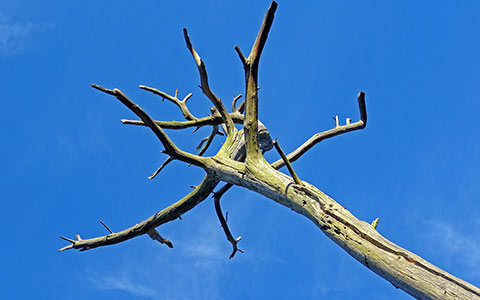
Does your tree look sick or like it’s going to fall? By knowing the signs of a hazardous tree on your property, you can take action to prevent catastrophic damages and losses.
72tree.com gathered information on the signs of a dead, dying, or dangerous tree, and whether or not it should be removed.
When Is Tree Removal Necessary?
You may need to remove your tree if it:
• Is dead or dying
• Is Rotting or hollow
• Has invasive or destructive roots
• Has been infested and poses a threat to surrounding trees
• Is diseased and could infect other trees or plants
• Poses an imminent threat to people, structures, or vehicles
Trees go through many phases as they mature. When any irregularities are detected, you should contact a professional tree service immediately. Have the tree professionally evaluated and make an informed decision on whether or not to remove the tree.
Is My Tree Dead or Dying?
The answer to that question is: Possibly. A deciduous tree may look dead, when in fact, it may only be dormant. Consider the following when evaluating your tree:
Deciduous Trees – A deciduous tree is one that loses its leaves in the fall and goes into a state of dormancy until the end of the winter season. These trees may look dead while in dormancy but are likely very much alive.
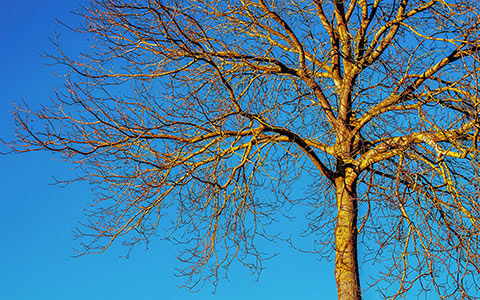
You can confirm this by performing a “scratch test” on a smaller branch or twig. If the twig is dead, it will be dry and brittle underneath the bark. A live one will have a shade of green and be moist under the bark.
Evergreen Trees – An evergreen tree maintains its foliage throughout the year. If you notice an excessive loss of foliage or the discoloration of a large portion of the tree, there may be root, sun, or wind damage.
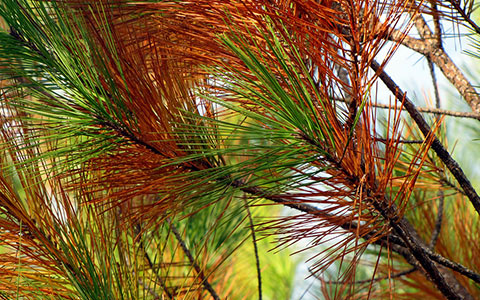
The following are signs of trouble for any tree and should be evaluated by a certified arborist immediately:
• The unusual or untimely loss of foliage
• Sections of the tree failing to leaf out in the spring
• Discoloration or wilting of a section of the tree crown
• New foliage is stunted, wilted, or discolored
• Mushroom conks are growing on the trunk or on surface roots
• Sprouts or suckers growing from the roots of the tree
• Entry or exit holes from boring insects
• Dead branches in the crown
• Sudden shedding of branches
• Your tree has begun to lean
• Neighboring trees are dying suddenly
• Mold or mildew has grown on a significant portion of the foliage
• There is significant damage to foliage from an insect infestation
• Your tree was struck by lightning
• Large portions of bark have been damaged or fallen off the trunk
• A severe storm has stripped your tree of foliage and damaged multiple branches
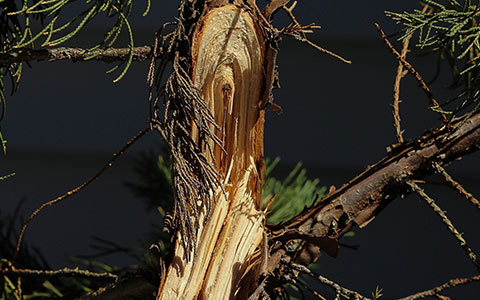
Through the life of a tree, it will face many health threats. In most cases, it can overcome those threats and continue thriving. However, when the tree is confronted by multiple threats, its health may decline, allowing some of those threats to damage it severely enough to kill it.
Many of the above signs can be mitigated or completely avoided when detected in their earliest stages. You can accomplish this by having an annual inspection performed on your tree(s) in late winter or early spring.
Read more about identifying tree diseases and trouble at 72tree.com/signs-diseased-tree-dieback-suckers-water-sprouts/
Removing Nuisance Trees from Your Property
Some tree species can become a tremendous nuisance as they mature and thrive. Some of the problems they may cause include:
• Interfering with power lines
• Branches overhanging your house, garage, or neighbor’s property
• Invasive roots breaking foundations, invading septic tanks, or buckling concrete
• Large roots growing along the ground surface
• The tree is self-pruning and begins to shed large limbs (eucalyptus trees do this frequently)
Invasive root systems like those of the aspen species can cause massive amounts of damage in a short amount of time. Read more about invasive root problems at 72tree.com/tree-roots-buckling-concrete-driveway/
In cases where a tree is near or on your property line, arguments and disputes may occur between neighbors. Before taking any action, you will need to determine ownership and/or responsibility of that tree. Read 72tree.com/who-is-responsible-overhanging-tree-branches/ to learn how this is determined.
Do I Need A Tree Removal Permit
Cities and municipalities across the country have tree ordinances in place to protect or preserve their trees. That said, there are cases in which dead trees or trees that pose an imminent threat of falling can be removed immediately and without a permit. However, you will likely be required to document the hazard and the need for removal fully. A certified arborist’s report, in some municipalities, may also be required.

You can hire our arborist, or search for an arborist or verify one’s credentials by visiting treesaregood.org/findanarborist/arboristsearch
Special Trees – Some tree species are vigorously protected in some municipalities, and their removal, for any reason without permission, may result in steep fines, recompense, and even planting new trees of the same or predetermined species, as defined by the tree ordinance. These reasons may include:
• Historical significance
• Age
• Size
• Rare or protected species
• Wildlife refuge
• Trees with a specific diameter at breast height (DBH)
Whenever you have a tree that needs to be removed (for any reason), consult your city’s codes and ordinances to determine whether you need a permit or not. The following may help as well:
• Visit your city’s website and search for tree removal permit information
• Call your city’s arborist or Forestry department
• Hire a professional tree service that can acquire the appropriate permits and do the job.
When it comes to trees, medium and large trees should always be handled by professionals. If you try to cut such a tree down without the proper knowledge and equipment, you may be placing your property and your life in jeopardy.
Removing Trees from Your Property
In this article, you discovered how to determine when a tree is dead, dying, has become a hazard, and if it should be removed.
By taking action when you detect a tree illness, infestation, or damage, you are preserving the safety of your property.
When you delay taking care of sick or wounded trees, you are leaving an open invitation for catastrophic events that can destroy your property and threaten the well-being of you and your loved ones.
Sources:
extension.umd.edu/hgic/topics/how-do-you-decide-when-remove-tree
extension.umn.edu/solve-problem/plant-diseases#tree-and-shrub-diseases-1872363
entomology.ca.uky.edu/ent43
myminnesotawoods.umn.edu/wp-content/uploads/2014/06/MNLawTrees-NuisanceTrees.pdf
Notice: Undefined variable: page in /home/vrxdg1855sn3/public_html/wp-content/themes/72tree/content.php on line 15
Notice: Trying to get property 'ID' of non-object in /home/vrxdg1855sn3/public_html/wp-content/themes/72tree/content.php on line 15
How To Kill and Stop Tree Stumps from Growing Back
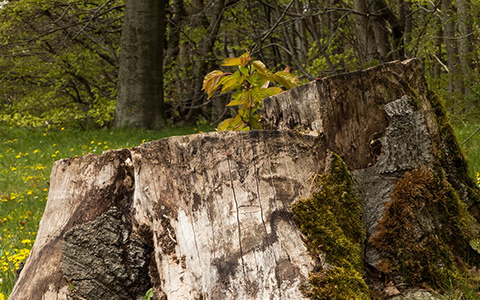
Is the tree you cut down trying to grow back from the stump? Many times, when trees get cut down, the stump and roots will continue to send out new growth. Knowing why they do this and what to do with it once the tree is gone can save you loads of time, effort, and money.
72tree.com assembled the following information on why trees grow back after being cut down, how to kill a tree stump, and remove it.
Do Trees Grow Back After Being Cut Down
Yes, they can. That’s why it’s essential to be knowledgeable about tree growth when you need to remove one permanently.
Cut trees with enough stored sugars and nutrients in their roots can produce sprouts from the roots and trunk as a measure of survival and reproduction. The following species will commonly sprout after being cut down:
• Poplars
• Maples
• Lindens
• Boxelder
• Red Oak
• Willows
• Beech
• Ash
When this survival mechanism is triggered, single, or multiple sprouts may appear. If left unabated, these sprouts will grow into trees without having grown a stable root plate, and likely pose a much more immense falling hazard than the original tree.
How to Stop Tree Stumps and Roots from Sprouting
Before you select a method to kill or remove a tree stump, evaluate the potential impact on the environment and immediate surroundings. The following are methods to eliminate tree stumps from sprouting:
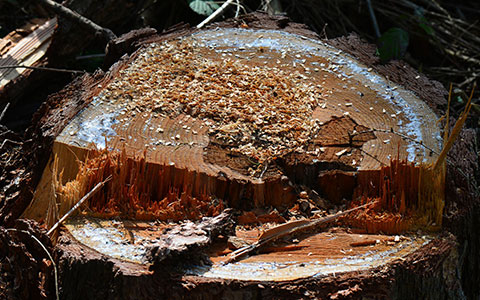
Use Fertilizer for Rapid Decay – To accelerate the decaying process of the stump, do the following:
• Cut the stump to soil level
• Drill half-inch to inch-wide holes six to eight inches deep into the stump and aerial roots
• Apply a slow-release fertilizer to the holes and over the stump
• Cover and “mound” with soil
With little to no impact on the environment, this method is highly effective but takes several months to decompose the stump fully.
Note: In this and the following methods, areal roots are the large protruding “anchor” roots at the base of the stump.
Using Epsom or Rock Salt to Kill It – This process is one of the more economical, but takes several months to kill the stump. Apply this method by:
• Acquiring enough Epsom or rock salt to fill several deep holes and cavities in the stump
• Drill half-inch to inch-wide holes six to eight inches deep into the stump and aerial roots
• Pack the holes and any cavities with salt
• Use hot wax or another water-proof sealant to seal the holes and cover the cavities
• Secure a dark plastic tarp or trash bag over and around the stump to keep rain and sunlight out
In six to ten weeks, your tree stump should be dead and breaking apart.
Tip: While table salt will produce similar results, it is very harmful to the soil in the vicinity of the stump. Use only 100% Epsom or rock salt with no added ingredients.
Cover The Stump To Kill It – You can slowly kill your tree stump with this method, and it’s free.
• Secure a dark plastic tarp or trash bag over and around the stump to keep rain and sunlight out
Without adding any chemicals or salt, this method will take up to six months for the stump to die and start to decay.
While the tree is covered, there should be no growth. However, if sprouts do appear while the stump is still alive, cut them off.
Burn The Stump – Burning the stump is an effective way to remove it after it has died. The following steps will help you safely burn and remove your tree stump:
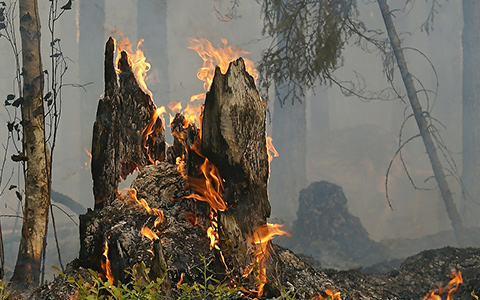
• Drill several half-inch to inch-wide holes six to eight inches deep into the stump and aerial roots. The deeper you can drill into the stump will ensure that it burns to the roots.
• Pour enough kerosene into the holes to thoroughly saturate the stump.
• Build a fire on top of the stump by placing scrap wood, twigs, and small logs on it. As the fire burns down, add more wood as necessary to keep the fire ablaze.
• When the stump has burned away, remove the ashes and replace them with soil.
As with any controlled burn, never leave it unattended. Keep a hose or fire extinguisher on hand in case the fire gets out of hand or begins to spread.
NOTE: Before using this method, consult your municipal ordinances to ensure that your controlled burn is legal, for more information call 411.
Tip: Turn the stump burning into a “bonfire” and invite friends and family over for an outside gathering.
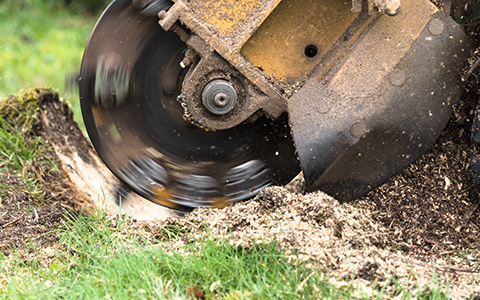
Grind The Stump – Grinding the stump allows you to chop it up and remove it immediately. This method requires protective clothing and equipment and some knowledge of machinery operation and safety. The following steps will help you safely remove your tree stump:
• Use a chainsaw to cut the stump as close to the ground as possible, leaving a level surface
• Grind the stump and any areal roots until fully ground up
• Remove the wood chips (use them for mulch or discard them)
• Fill the hole with fresh soil
Keep children and pets at a safe distance while the stump grinder is in use.
Note: Before operating this or any other machinery, refer to the operating manual to ensure its proper and safe use. There may be safety features that you are not aware of on the machine.
Call A Professional Tree Service – Take all of the stress, equipment, time, and chemicals out of the process by calling a professional tree service to come out and remove your tree stump. They have specialized equipment and experience to remove your tree stump quickly and safely.
Stop Your Tree Stump from Growing Back
In this article, you discovered why trees continue sending up sprouts after being cut down, how to kill a tree stump, and how to completely remove one.
By killing and removing your tree stump, you are preventing sprouts from growing and creating a hazard to surrounding structures and people.
Allowing a tree to re-grow in this manner is significantly dangerous. These new trees grow without establishing a firm root plate and may topple as they increase in size without warning.
Sources:
umass.edu/urbantree/factsheets/26killastump.html
ucanr.edu/blogs/blogcore/postdetail.cfm?postnum=20662
warnell.uga.edu/sites/default/files/publications/Stump%20Removal%20pub_14-8.pdf
Notice: Undefined variable: page in /home/vrxdg1855sn3/public_html/wp-content/themes/72tree/content.php on line 15
Notice: Trying to get property 'ID' of non-object in /home/vrxdg1855sn3/public_html/wp-content/themes/72tree/content.php on line 15
Caring for and Planting a Potted Christmas Tree
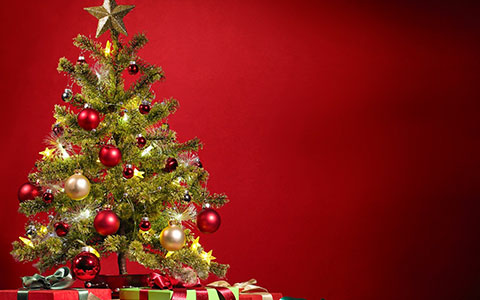
With some simple steps, you can avoid significantly damaging your potted Christmas tree while it’s in your home. Likewise, by taking a few essential measures into consideration, your potted Christmas tree will thrive outside for years to come.
72tree.com assembled the following list of care and planting tips for your potted Christmas tree.
Potted Christmas Tree Selection
Responsible tree care begins with your tree selection. The following will help you get the right tree for your holiday enjoyment and avoid transporting a potential infestation or tree disease to your landscape:
• Some highly sought after species for potted Christmas trees include Fraser fir, white pine, and Norway, white and Colorado blue spruces.
• The species should be adapted to your USDA hardiness zone
• The root ball or soil in the pot should be moist
• The tree should appear sturdy with even growth
• There should be no signs of disease or infestation
• Little to no needles should fall off the tree when shaken
• Branches and needles should be pliable when run through your hand
• Look for potted trees that are kept outside (these trees should be in a state of dormancy)
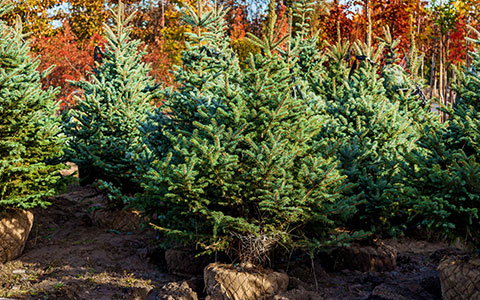
If the tree is purchased from a climate-controlled nursery, avoid trees with new growth at the end of its stems. This new growth (triggered by the warmth indoors) will appear bright green. It will not have time to harden before being planted outside and exposed to winter temperatures after the holiday.
Visit 72tree.com/trees-shrubs-usda-hardiness-zone-map/ to learn more about the hardiness zones and how to determine your precise zone.
Tip: Look for trees in the 4 to 5-foot range. Since these trees still have their roots and surrounding soil, they will be much heavier than live cut trees. The taller the tree, the more roots and soil are required. Thus, the shorter the tree, the more manageable it will be during transport and planting.
How To Bring Your Potted Christmas Tree Indoors
Now that you have the perfect tree for your holiday celebration, use the following steps to acclimate the tree to come indoors:
Garage Your Tree – When you arrive home, leave your tree in the garage for two to three days. This will allow the tree to get used to warmer temperatures and avoid stressing it.
Stressed trees are highly susceptible to successful insect and disease attacks.
Digging A Hole for the Tree – While the tree is acclimating to go indoors, take some time to prepare its planting location outdoors. Take the following into consideration:
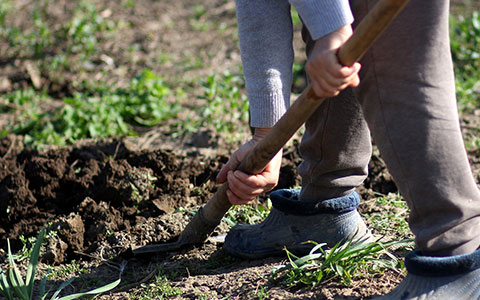
Know the species height and width at maturity. Your tree is likely capable of reaching heights of 80 to 100-feet and width of 20-feet or more. Choose a location away from power lines and at least 30-feet from any structures or paved areas in your landscape.
Now that you have a location, dig a hole 3-feet across and as deep as the root ball or pot. Keep the dug up soil in the garage (protected from freezing), fill the hole with straw, and cover it with wooden planks. This will help you avoid significant delays in case the ground freezes.
Inspect Your Tree – Once acclimated, thoroughly inspect your tree once more for signs of insect infestation before bringing it indoors.
Some of the potential insect passengers you may find include:
• Aphids
• Bark Beetles
• Scale
• Lanternflies
• Stink Bugs
Visit 72tree.com/preventing-eliminating-christmas-tree-bugs/ to read more about Christmas tree bug control and prevention.
Timing and Duration – Potted Christmas trees should be brought indoors as close to your holiday celebration as possible. Unlike cut Christmas trees, potted trees will react to the warmer temperature indoors and begin to exit dormancy.
From the time your tree is brought indoors, you have about ten days before you will need to get it back outside. While your tree is indoors, observe the following to promote its health:
• Place the tree in a location far from heat sources, including fireplaces, vents, portable heaters, stoves, etc.
• Use led lights on the tree to avoid drying it out. If conventional light strings are used, be sure to limit the time they are turned on.
• Water the tree daily with 30 to 40 ice cubes placed on the root ball or the soil in the pot.
• Help the tree remain in dormancy by putting it in a cooler room with an abundance of natural light.
Tip: If you detect any new growth or signs of sprouting at any time, remove all of the decorations and lighting. It’s time to get it outside.
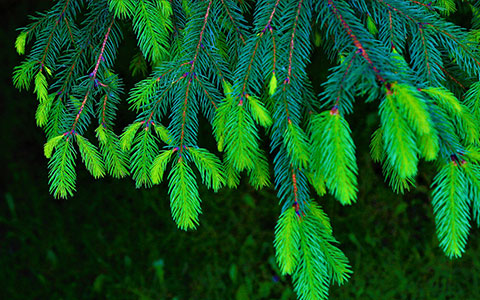
How To Take Your Potted Christmas Tree Outdoors
The same way you acclimated your tree to come indoors, you will need to acclimate it to go outdoors. You can accomplish this by removing all decorations and lighting, then moving it back to the garage for two to three days.
Planting Your Christmas Tree
The following steps will help you successfully plant your acclimated tree:
• Uncover the hole you previously dug and remove the straw
• Move the saved soil back to the side of the hole
• Fill the hole with water, let the water soak into the ground, and repeat
• Move the tree to the edge of the hole and gently lay it on its side (with the top of the tree pointing away from the hole)
• Carefully remove the pot (keep the soil intact)
• If the root ball is wrapped in burlap, leave the burlap on for now
• Slide the tree towards the center of the hole, so the root ball is at the center of the hole
• Raise the tree into its position (remove the burlap now)
• Loosen the soil in the root ball and free any circling roots
• Fill in the hole making sure the root flare does not get buried
• For stability, it may be necessary to stake the tree for the first 6 months
• Water the tree and add a 3-inch layer of organic mulch around the entire base without covering any part of the trunk
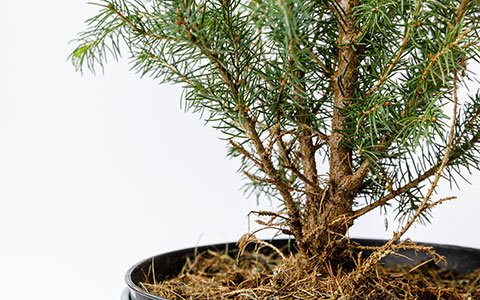
For more tips and guidance on successfully planting a tree, read 72tree.com/beginners-guide-tree-planting/
Note: If the ground has frozen, there is snow accumulation, or if your tree sprouted new growth and began to bud, don’t plant it just yet. Keep it and continue caring for it in the garage until the threat of freezing temperatures has passed.
Potted Christmas Tree Care And Planting
In this article, you discovered what it takes to care for a potted Christmas tree and plant it when your holiday celebrations are over.
By properly acclimating and caring for your potted tree, you can keep it from harm’s way and enjoy its beauty for years to come.
By neglecting the needs of your potted Christmas tree, it will likely end up stressed and suffering permanent damage.
Sources:
content.ces.ncsu.edu/selection-and-care-of-living-christmas-trees
canr.msu.edu/news/living_christmas_trees_another_real_tree_option
bbg.org/news/is_a_potted_christmas_tree_a_good_idea
Notice: Undefined variable: page in /home/vrxdg1855sn3/public_html/wp-content/themes/72tree/content.php on line 15
Notice: Trying to get property 'ID' of non-object in /home/vrxdg1855sn3/public_html/wp-content/themes/72tree/content.php on line 15
Common Maple Tree Diseases, Symptoms, Treatment, and Prevention
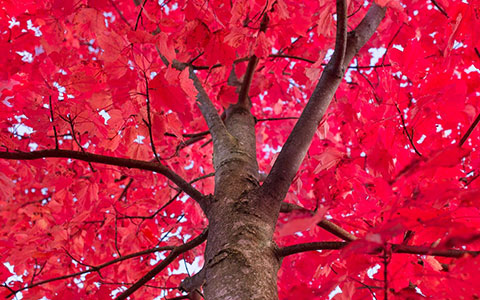
Stop your maple tree from needlessly dying. If caught in time, diseases that attack maples can be treated with success.
72tree.com of Alpharetta Ga, assembled the following list of diseases that affect maple trees, how to identify, treat, and prevent them.
Why do My Maple Tree Leaves Have Spots?
One of the easiest ways to detect maple tree diseases is through irregularities in shape or size, spots, and/or blemishes on the tree’s foliage.
The following diseases may cause spots to appear on your maple tree’s foliage:
Leaf Spot (Phyllosticta minima) – This fungal infection causes round spots about a quarter of an inch in diameter to appear on leaves. These spots will have a pronounced purple border and blackish dots in the center of the spot (fungal fruiting structures).
Treatment: Before fall, prune dead twigs, stems, and branches. Collect all clippings and destroy them (burning them is highly recommended) to prevent the spread of the fungus.
Have the tree evaluated to determine the extent of the infection and whether further action like using fungicides should be taken to protect your tree and surrounding landscape.
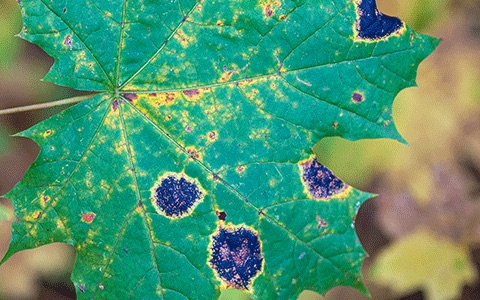
NOTE: Sanitize all equipment, including gloves and protective clothing that come in contact with an infected tree and its foliage.
Anthracnose (Aureobasidium apocryptum or Discula – Gloeosporium) – Anthracnose is a fungal infection that causes purple or brown streaks to occur alongside and between leaf veins. In some maple species, drought and heat stress can produce similar symptoms. You can confirm an anthracnose infection by locating small, brown fungal fruiting structures near the veins of affected leaves.
Treatment: The same measures and precautions for leaf spot should be used in the treatment of anthracnose.
NOTE: Anthracnose can lead to severe defoliation during a wet spring season.
Root Rot (Fomes fomentarius, Ganoderma lucidum, or Laetiporus sulfureus) – Once a fungal infection embeds itself in the trunk or the roots of a maple tree, there are three types of symptoms to watch for:
• Foliage in the entire crown or a section of it may suffer from chlorosis, wilt, die and eventually fall. This happens as the fungi cause hydraulic failure within the roots, trunk, and branches.
• Fungal fruiting structures (mushroom conks) will appear from late spring to mid-fall. For these structures to form, there must be rotting organic material within the tree.
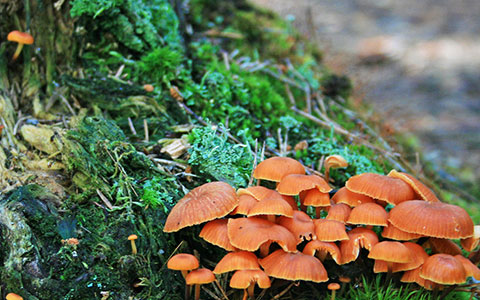
• Large black ants known as carpenter ants will make a nest for their colony within trees that suffer from heart rot. These ants do not burrow through heartwood, they remove the tissues rotting and softened from the infection.
Treatment: Once root rot or heart rot has been confirmed, have the tree professionally removed as quickly as possible.
NOTE: The presence of carpenter ants and fungal fruiting structures only occur after significant damage has been done to the tree. When the affected tree is within striking distance of your home, places where people congregate, or other structures and vehicles, the situation should be treated as an emergency.
Galls – These spots are irregular growths or swellings that occur from a reaction to tissue feeding or egg-laying by various species of mites and insects (commonly mistaken for fungal infection).
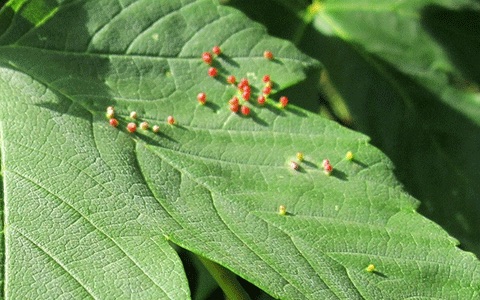
Galls appear in various ways. Each mite or insect species produces a distinctive gall shape and can range from wart-like bumps to felt-like patches to spindle-shaped protrusions. Galls develop in the spring, and once formed, the pest remains protected within the structure. Arborists can often identify which mite or insect has infested your tree by the shape and appearance of the galls.
Treatment: Leaf galls are relatively innocuous and rarely result in any long term damage to the tree. Applications of pesticides are relatively ineffective, as the pests are protected within the gall structure.
The most effective manner of gall removal is to handpick and destroy affected foliage before exit holes form and allow the pest(s) to move on. If the presence of galls is overwhelming, hire a professional tree service to evaluate the situation and recommend a course of action.
Maple Tree Disease Prevention
Maple tree disease prevention begins with good tree care practices. The healthier your tree is, the more vigorously it can fight back against diseases and infestations.
However, when the tree’s defenses fail, here are steps to prevent the disease or infestation from infecting surrounding trees:
• Prune affected limbs (before leaf-drop)
• Burn all pruned limbs and foliage
• Always sanitize pruning equipment after use on an infected tree
• Avoid tracking soil from around infected trees to areas around uninfected trees (many fungi and other pathogens thrive in the soil). Clean boots, protective clothing, tools, and equipment before leaving an infested area
• Replant resistant species after tree removal
• Avoid planting maple trees in areas with a history of tree diseases
• Have annual tree inspections and soil testing performed to detect any issues early on.
Black Spots on Maple Leaves
In this article, you discovered how to identify diseases that cause spots on maple tree leaves, how to treat them, and how to prevent them.
Prevent the decline of your maple tree by knowing what to do when a fungus or pathogen begins showing signs of infection.
Your choice to ignore signs that your tree is diseased or in decline can result in catastrophic fungal outbreaks to your landscape, or costly damages to your property when the tree falls.
Sources:
extension.psu.edu/maple-diseases
hgic.clemson.edu/factsheet/maple-diseases-insect-pests/
pnwhandbooks.org/plantdisease/host-disease/maple-acer-spp-verticillium-wilt
